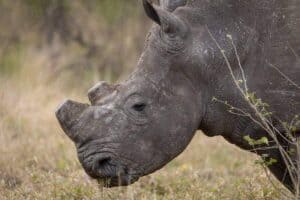For more than a decade, the K9 unit has increased the number of apprehensions and arrests of poachers in the KNP.

The collaboration between anti-poaching K9 units and new antipoaching technologies will not only see a significant decline in poaching numbers across the country, but will also take the fight against wildlife crime to a new level.
Despite anti-poaching technologies reportedly vulnerable to cyberattacks, the Kruger National Park’s (KNP) K9 unit, along with the tech, “will yield more successes better than before”, according to the park’s K9 operator Samuel Madalane.
Rhino poaching
For more than a decade, the K9 unit has increased the number of apprehensions and arrests of poachers in the KNP and in the last financial year, the park reported 180 cases of rhino poaching, a 45% decline compared to the previous years.
Madalane said the park installed at least three CCTV cameras within the park, especially in areas where a larger population of rhinos can be found.
ALSO READ: Kruger Park ranger nabbed for trying to sell pangolin
“These cameras are equipped with infrared technology to detect movement at night. We always look at the trend of different vehicles. Once we’ve picked up a specific trend, we register the vehicle from every part of the park,” he added.
“We can pick up an illegal trend easily when the person is actually doing more movements around one place and then we deploy men to go and investigate.
“Like, if the same vehicle travels through the park and the number of people in the vehicle reduces, then we know that there is a specific movement we need to keep an eye on.
“Through this system, we have been very successful. Poachers are being detected at the fences and the river, keeping up with their changing ways.”
ALSO READ: Shortage of rangers at Kruger Park endangers rhinos
Madalane also said tracking with the units allows the rangers to cover more ground, while looking out from a helicopter.
“The dogs run at 45km/h, making it easier to trace and find the poachers.”
Kruger’s K9 unit
In collaboration with the Southern African Wildlife College, the park’s K9 unit has grown from three to 55 dogs and has extended to other national parks, with 75 dogs across the country, which have introduced the trend of tracking alone without supervision.
“When the Kruger started without dogs, they always had a three to four percent success rate, and then moved to 45% success rate when they introduced their dogs. But with this collaboration, it went up extremely high, to 70% without the pack dogs,” the college’s Dion Lowe said.
ALSO READ: SANParks explains decision to rotate anti-poaching rangers
“For every time we release our pack dogs on a track, we have an 80% chance of catching the poachers. In the past five years, we have arrested over 200 poachers and that is a very high number.
“We have also taken over 90 rifles out of the system that were used for poaching and, over that time, looking at how many rhinos we have saved, it goes up to 80.”
Operations centre manager Sandra Sterling said the vehicle recognition devices were strategically set up near intensive protection zones which cover nine types of landscapes in the Marula South KNP site.
Sterling said despite failure to see where some of the vehicles turn or which routes they pick, “we can always trace them back and ensure that they are on radar with the rangers, so even if we don’t track them by footage, then at least the rangers can keep an eye and ear out”.
“We communicate with rangers to ensure successful operations, while also now being better equipped to deal with tourists who are lost without deploying helicopters,” she said during a demonstration of CCTV cameras.
“The cameras allow for us to narrow down points of wanted and unwanted movements. And even after that, we can track movements, even when a specific car comes back within the park, its movement, and trends.”
ALSO READ: South Africa’s rhino graveyard is running out of space
She also said the park was planning to install another 12 CCTV cameras from all gates within the park.
“This will help monitor more movements, even in places poachers and everyone else never imagined we could.”






